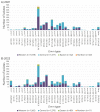Invasive group A streptococcal disease surveillance in Canada, 2021-2022
- PMID: 38835501
- PMCID: PMC11149783
- DOI: 10.14745/ccdr.v50i05a03
Invasive group A streptococcal disease surveillance in Canada, 2021-2022
Abstract
Background: Invasive group A streptococcal (iGAS, Streptococcus pyogenes) disease has been a nationally notifiable disease in Canada since 2000. This report summarizes the demographics, emm types, and antimicrobial resistance of iGAS isolates collected in Canada in 2021 and 2022.
Methods: The Public Health Agency of Canada's National Microbiology Laboratory collaborates with provincial and territorial public health laboratories to conduct national surveillance of invasive S. pyogenes. Emm typing was performed using the Centers for Disease Control and Prevention emm sequencing protocol or extracted from whole-genome sequencing data. Antimicrobial susceptibilities were determined using Kirby-Bauer disk diffusion according to Clinical and Laboratory Standards Institute guidelines or predicted from whole-genome sequencing data based on the presence of resistance determinants.
Results: Overall, the incidence of iGAS disease in Canada was 5.56 cases per 100,000 population in 2021, decreasing from the peak of 8.6 cases per 100,000 population in 2018. A total of 2,630 iGAS isolates were collected during 2022, representing an increase from 2021 (n=2,179). In particular, there was a large increase in isolates collected from October to December 2022. The most predominant emm type overall in 2021 and 2022 was emm49, at 21.5% (n=468) and 16.9% (n=444), respectively, representing a significant increase in prevalence since 2018 (p<0.0001). The former most prevalent type, emm1, increased from 0.5% (n=10) in 2021 to 4.8% (n=125) in 2022; similarly, emm12 increased from 1.0% (n=22) in 2021 to 5.8% (n=151) in 2022. These two types together accounted for almost 25% of isolates collected in late 2022 (October to December). Antimicrobial resistance rates in 2021 and 2022 included: 14.9%/14.1% erythromycin resistance, 4.8%/3.0% clindamycin resistance, and <1% chloramphenicol resistance.
Conclusion: The increase of iGAS isolates collected in Canada is an important public health concern. Continued surveillance of iGAS is critical to monitor expanding emm types and antimicrobial resistance patterns.
Keywords: Canada; Streptococcus pyogenes; antimicrobial resistance; emm; group A Streptococcus; iGAS; surveillance.
Conflict of interest statement
Competing interests None.
Figures






Similar articles
-
Comparison of pharyngeal and invasive isolates of Streptococcus pyogenes by whole-genome sequencing in Toronto, Canada.Microbiol Spectr. 2025 Apr;13(4):e0214124. doi: 10.1128/spectrum.02141-24. Epub 2025 Feb 13. Microbiol Spectr. 2025. PMID: 39945517 Free PMC article.
-
Invasive group A streptococcal disease surveillance in Canada, 2020.Can Commun Dis Rep. 2022 Sep 1;48(9):407-414. eCollection 2022 Sep 1. Can Commun Dis Rep. 2022. PMID: 38106647 Free PMC article.
-
Clinical, microbiological, and molecular characterization of pediatric invasive infections by Streptococcus pyogenes in Spain in a context of global outbreak.mSphere. 2024 Mar 26;9(3):e0072923. doi: 10.1128/msphere.00729-23. Epub 2024 Mar 5. mSphere. 2024. PMID: 38440985 Free PMC article.
-
Genomic cluster formation among invasive group A streptococcal infections in the USA: a whole-genome sequencing and population-based surveillance study.Lancet Microbe. 2024 Dec;5(12):100927. doi: 10.1016/S2666-5247(24)00169-1. Epub 2024 Oct 15. Lancet Microbe. 2024. PMID: 39419051
-
Invasive Streptococcus pyogenes disease in Spain: a microbiological and epidemiological study covering the period 2007-2019.Eur J Clin Microbiol Infect Dis. 2021 Nov;40(11):2295-2303. doi: 10.1007/s10096-021-04279-2. Epub 2021 May 27. Eur J Clin Microbiol Infect Dis. 2021. PMID: 34046804
Cited by
-
Group A streptococcal infections in Alberta, Canada 2018-2023.Epidemiol Infect. 2024 Dec 23;153:e35. doi: 10.1017/S0950268824001857. Epidemiol Infect. 2024. PMID: 39711024 Free PMC article.
-
Invasive Group A Streptococcus Hypervirulent M1UK Clone, Canada, 2018-2023.Emerg Infect Dis. 2024 Nov;30(11):2409-2413. doi: 10.3201/eid3011.241068. Epub 2024 Oct 20. Emerg Infect Dis. 2024. PMID: 39428565 Free PMC article.
-
Group A Streptococcus Infections in Children: Epidemiological Insights Before and After the COVID-19 Pandemic.Pathogens. 2024 Nov 15;13(11):1007. doi: 10.3390/pathogens13111007. Pathogens. 2024. PMID: 39599560 Free PMC article. Review.
-
Comparison of pharyngeal and invasive isolates of Streptococcus pyogenes by whole-genome sequencing in Toronto, Canada.Microbiol Spectr. 2025 Apr;13(4):e0214124. doi: 10.1128/spectrum.02141-24. Epub 2025 Feb 13. Microbiol Spectr. 2025. PMID: 39945517 Free PMC article.
-
Molecular and Clinical Characterization of Invasive Streptococcus pyogenes Isolates: Insights from Two Northern-Italy Centers.Pathogens. 2025 Feb 5;14(2):152. doi: 10.3390/pathogens14020152. Pathogens. 2025. PMID: 40005528 Free PMC article.
References
-
- Golden A, Griffith A, Demczuk W, Tyrrell G, Kus J, McGeer A, Domingo MC, Hoang L, Minion J, Van Caeseele P, Smadi H, Haldane D, Zahariadis G, Mead K, Steven L, Strudwick L, Li A, Mulvey M, Martin I. Invasive group A streptococcal disease surveillance in Canada, 2020. Can Commun Dis Rep 2022;48(9):407–14. 10.14745/ccdr.v48i09a05 - DOI - PMC - PubMed
-
- World Health Organization. Disease Outbreak News; Increased incidence of scarlet fever and invasive Group A Streptococcus infection - multi-country. 2022. [Accessed 2023 Nov 26]. https://www.who.int/emergencies/disease-outbreak-news/item/2022-DON429
-
- Spellerberg B, Brandt C. Streptococcus. In: Jorgensen JH, Carroll KC, Funke G, Pfaller MA, Landry M, Richter SS, Warnock DW, editors. Manual of Clinical Microbiology, 11th ed. Washington, D.C.: ASM Press; 2015. p. 383–402.
-
- Clinical and Laboratory Standards Institute (CLSI). Performance Standards for Antimicrobial Disk Susceptibility Tests: M02, 13th ed. Wayne, PA: CLSI; 2018.

